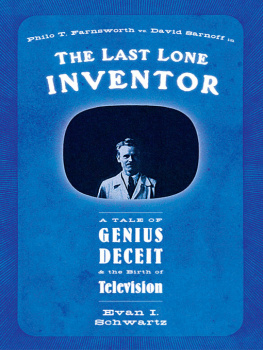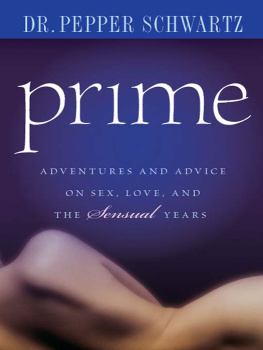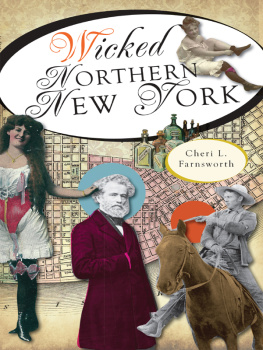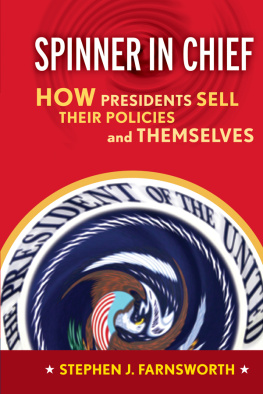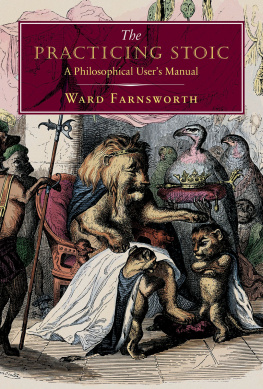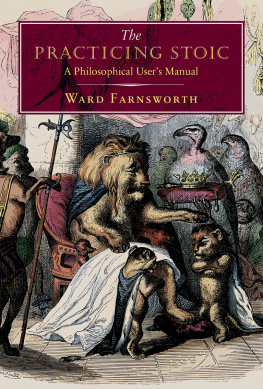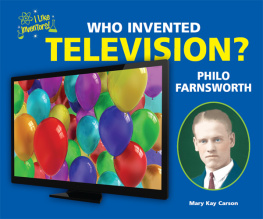PERFECTBOUND E-BOOK EXCLUSIVE EXTRA
The Last Lone Inventor has been four years in the making. Heres the step-by-step timeline of how the whole project unfolded.
May 20, 1998: An Idea Strikes
I was at a reception at the Museum of Television and Radio on 52nd Street in New York. The occasion: an evening ceremony for the Global Business Book Awards. My first book, Webonomics, about business on the Internet, was up for an award that I was sure to lose (and, in fact, did). At the time, I was already interested in Philo T. Farnsworth and the invention of television, and was mainly attracted by the many parallels between the birth of broadcasting and the early development of the Web new information technology bursts on the scene, fueling a massive stock market bubble, government trustbusters target the industrys most powerful player, and the public is enthralled yet clueless as to whats really going on. When I visited the museum bookshop, filled with volumes about the early history of broadcasting, I was specifically looking for a book focusing on Farnsworth and his battle against RCAs David Sarnoff. I couldnt find one.
August 12, 1998: Visiting Philos Lab
I happened to be in San Francisco, and I felt an urge to visit 202 Green Street, the spot on Telegraph Hill where Philo T. Farnsworth in the late 1920s established his laboratory and invented electronic television. The location seemed so dramatic, and I began imagining what it was like when Farnsworth was here. I was startled to see that there was a company called Philo Television listed above the doorbell. I rang it and was invited upstairs. Turns out this was (and still is) the modern-day home of a video production and editing shop staffed with employees who like me think Farnsworth is really cool. They even had photos of Philo on the walls.
December 10, 1999: Phone Call to Pem
I had finished writing my second book, Digital Darwinism, by the end of 1998, and I had spent much of 1999 touring and promoting it. Finally, I had some time to sit down and work on the Farnsworth proposal. I knew Pem Farnsworth, the inventors widow, was still alive (at age ninety-one), and my agent encouraged me to find her. I tracked down her phone number, but I was nervous about calling her and asking her to revisit what I imagined must certainly be painful memories. As soon as Pem answered the phone, I knew Id made the right call. She was clear as a bell and a delight to talk to. I asked her if I could come interview her in person, and she agreed.
December 17, 1999: The Farnsworth House
I arrived at the Fort Wayne, Indiana airport and made a call to the Farnsworth home. Pem said to come over in a couple of hours. She first needed to go to the beauty parlor. That afternoon, I showed up at her doorstep bearing a box of my wifes special holiday cookies. A woman in a purple pants suit answered the door. She invited me in to have a seat in the living room. I switched on my tape recorder. Pem and her youngest son, Kent, proceeded to tell me their stories, and before we knew it, we had filled up three cassettes.
April 28, 2000: The Other Side of the Story
To help move my research along, and to recoup some costs, I had proposed a story to MITs Technology Review about the Farnsworth versus Sarnoff battle. In the course of writing the piece, I got a hold of Alex Magoun, director of the David Sarnoff Library in Princeton, N.J. Hes a historian with a treasure trove of information, and he turned out to be invaluable in providing balance and perspective. (The resulting story, Who Really Invented Television? would be published in Tech Reviews September 2000 issue.)
August 16, 2000: Book Deal
My agent guided my book proposal to Marjorie Braman at HarperCollins, who by chance had been a closet Philo fan for years. We hit it off right away when we spoke on the phone, and a book deal was done within days.
October 4-5, 2000: Maine Lobsterfest
I spent two days visiting the famed Farnsworth cabin deep in the woods of Maine. This is where the inventor spent the years of World War II regaining his health after his nervous breakdown. Now the place was jammed with Farnsworths for a family reunion. Pem and Kent were there, as was Kents brother, the eldest surviving Farnsworth son, Skee Farnsworth, who was celebrating his sixty-fifth birthday with a lobster dinner. I was invited to put on a bib and join them.
January 17-19, 2001: Uncovering Documents
I embarked on a research trip for the book to the National Archives, the Library of Congress, and the Smithsonian in Washington, D.C., and to the David Sarnoff Library at in Princeton.
February 28-March 2, 2001: Back to Fort Wayne
I made my second visit to the Farnsworth home in Fort Wayne, spending three days interviewing Pem and going through documents, lab journals, and photographs with her and with Kent.
April 3-7, 2001: Hometown
I spent almost three days in Salt Lake City, home of the Special Collections Department at the University of Utahs Marriott Library, which houses the extensive Farnsworth collection of documents, news clippings, and photographs. But the highlight of the trip was my drive up north to Rigby, Idaho, where Farnsworth lived as teenager when he came up with his idea in the potato field. I was that days only visitor to Rigbys top cultural attraction, the Farnsworth Pioneer & Television Museum. Its a low-budget operation, but they actually have one of his original tubes there. Well worth the visit, if youre ever in Rigby.
May 15-18, 2001: Last Lone Research
I made additional trips again to the Library of Congress, and again to the Sarnoff Library, plus a stop in New York, to meet with my editor, who said she was expecting my manuscript in June!
July 9, 2001: FedEx Tracking Number
My manuscript arrived arrives at HarperCollins.
September 10, 2001: Delivery Not Attempted
I FedExed an edited version of the manuscript to the development people at Miramax Films (which optioned the book), to arrive at their office in lower Manhattan the following morning. And on that morning, suddenly this project no longer seemed so important... Nearly two weeks later, FedEx delivered the package. But by then I was beginning to feel that the story had taken on even more relevance. Television bound the nation together on September 11 and in its aftermath, yet at the same time it was being used in a vicious campaign of anti-Western propaganda in the Middle East. It brought into sharp relief the fact that Farnsworths invention was not an electronic box of trivialities but perhaps the most influential instrument ever introduced to humankind.
December 18, 2001: Judging the Cover
HarperCollins sent sends me the proposed cover design. I liked it.
May 7, 2002: Publication
The Last Lone Inventor: A Tale of Genius, Deceit, and the Birth of Television is scheduled to be available at a bookstore near you, and online, as a HarperCollins e-book. Of course, I hope that it will make a difference in the historical record to this day, the Encyclopedia Britannica, the World Book, and other authoritative references fail to even mention Philo T. Farnsworth in their accounts of how television was invented.
September 7, 2002: A Special Anniversary

